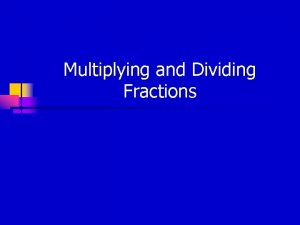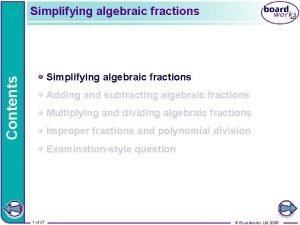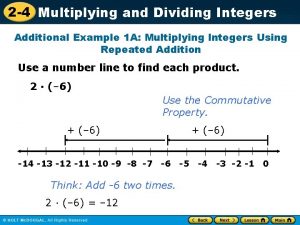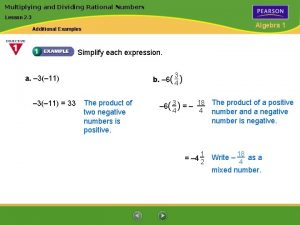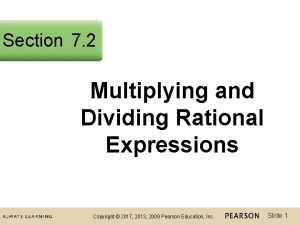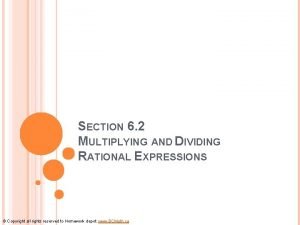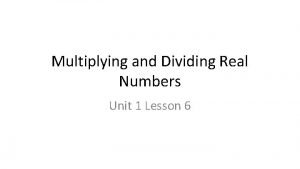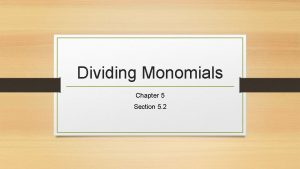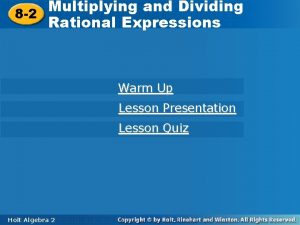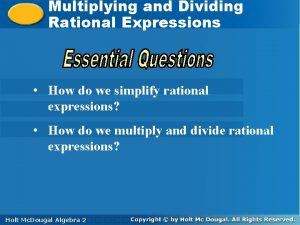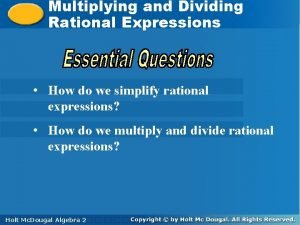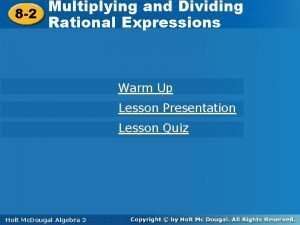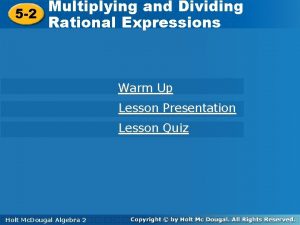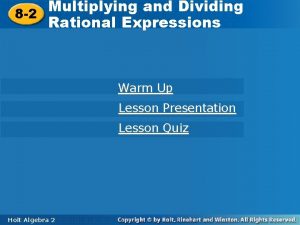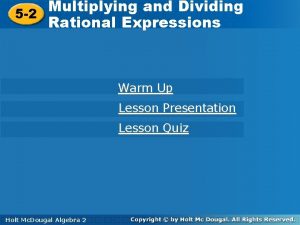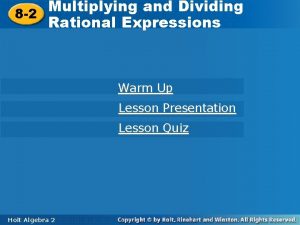Multiplying and Dividing Fractions Lesson Overview n After

















- Slides: 17

Multiplying and Dividing Fractions

Lesson Overview: n After going through this lesson you will: n n n Understand the concepts of multiplying and dividing fractions Understand the algorithms of multiplying and dividing fractions Be able to apply your new knowledge to solve multiplication and division problems involving fractions

A Quick Review: n You should remember that fractions have a numerator and a denominator. n The numerator tells how many parts we are talking about, and the denominator tells you how many parts the whole is divided into. So a fraction like 3/4 tells you that we are looking at three (3) parts of a whole that is divided into four (4) equal parts. n n There are different types of fractions n n ¾--The top number (3) is the numerator, while the bottom number (4) is the denominator. Proper (Example: ½) Improper (Example: 11/4) Mixed Number (Example: 1 5/6 changes to 11/6) When multiplying or dividing fractions, change a mixed number into an improper fraction, but when reducing, change an improper fraction back into a mixed number.

Why Multiply and Divide Fractions? n There are many reasons why we may need to multiply and divide fractions in real-life settings, such as: n n n To calculate a grade in a class To calculate money while grocery shopping, running errands, etc. To become better problem-solvers To be able to get correct measurements while measuring things such as an area of a room To ration portions of food equally among friends To get through your math classes!

Multiplying Fractions: n n What does 2 x 3 mean to you? One way to think of it is as “ 2 sets of 3. ” For example, “Max bought 2 packages of three balloons. ” What does 2 ½ x ¾ mean? It is the same as when multiplying whole numbers: “ 2 ½ sets of ¾. ” The first factor tells how much of the second factor you have or want. For instance, “Marga ate 2 ½ pieces of ¾ of a Hershey bar that was left. ”

More on Multiplying Fractions: n When we see the word “of” in a problem involving fractions, it means we need to multiply. Here is an example: n There are 8 cars in Michael’s toy collection. 1/2 of the cars are red. How many red cars does Michael have? n n This problem is asking “What is 1/2 of 8? ” A way to answer it is to put a multiplication sign in place of “of. ” You then get 1/2 x 8 or 8 x ½ (remember that multiplication is commutative).

Multiplication Continued: n What do you think 2/3 of 15 means? n n It means 2/3 x 15 It could mean anything. It is helpful if you think of a situation such as: n n Mike ate 2/3 of 15 cookies. Susie took 2/3 of her 15 marbles to school. The dog ran 2/3 of its 15 laps around the yard. You are just about ready to learn the rules/algorithm for multiplying fractions!

Multiplying Fractions: n n You may find that multiplying fractions is easier than adding or subtraction because you don’t need to find common denominators. Instead, you multiply straight across. Multiply numerators together. Multiply denominators together.

Algorithm—Multiplication: n Set up the fractions side-by-side. n n Multiply the numerators of the fractions and write the product as the numerator of the new fraction n n ½ X ¾ = 3/-- (1 X 3=3) Multiply the denominators of the fractions and write the answer as the denominator of the new fraction n n 1/2 X 3/4 ½ X ¾= 3/8 (2 X 4=8) Remember to write your answers in lowest terms!

A Few Examples: n Proper Fraction: 2/3 X 4/5 n n Improper Fraction: 9/2 X 3/7 n n Answer: 27/14=1 13/27 (9 X 3=27, 7 X 2=14) Mixed Number: 2 1/6 X 3/2 n n Answer: 8/15 (2 X 4=8, 3 X 5=15) Answer: 39/12=3 3/12=3 1/4 (13/6 X 3/2= 13 X 3, 6 X 2) Whole Number: 5 X 2/7 n Answer: 10/7=1 3/7 (5 X 2=10, 1 X 7=7)

Dividing Fractions: n n What does 8/2 mean? It means you are dividing 8 of something by 2 of something else. You could think of it as giving 8 pieces of candy to 2 friends. They would each get 4 pieces, right? What does 2 ½ / ¼ mean? The same as dividing with whole numbers. For instance, “Jack split 2 ½ pizzas with ¼ of his brothers. ”

Rules for Dividing Fractions n n n Change the "÷" sign to "x" and invert the fraction to the right of the sign. Multiply the numerators. Multiply the denominators. Re-write your answer as a simplified or reduced fraction, if needed. Example: ¼ / ½ changes to ¼ x 2/1 n 1/4 x 2/1=2/4=1/2

Why do We Invert in Division? n If you think about it, in the problem 1/2 / 1/3, we are dividing a fraction by a fraction, which looks like:

More on “Why do We Invert? ”: n n To make the problem easier, we want to get rid of the denominator (1/3). So, we multiply by its reciprocal (3/1) to get 1. Remember, though, if we multiply the denominator by a number, we must multiply the numerator by the same number. For more information, go to Ask Dr. Math So, this is what we get:

Algorithm: Dividing Fractions n n n Set up the fractions side-by-side as you would when multiplying fractions. (3/4 / 1/2) Now, you must invert the second number (called the divisor). Example: Change 1/2 to 2/1. Next, multiply straight across as you would when multiplying fractions n n n Multiply numerators together Multiply denominators So, ¾ X ½ becomes ¾ X 2/1 , which equals 6/4 or 1 ½ in lowest terms

Some Examples: n Proper Fraction: 3/4 / 5/6 n n Improper: 8/3 / 2/4 n n Answer: 32/6=16/3=5 1/3 (8/3 x 4/2) Whole Number: 5 / 1/3 n n Answer: 18/20=9/10 (3/4 x 6/5) Answer: 15 (5/1 x 3/1) Mixed Number: 2 1/4 / 2/3 n Answer: 27/8=3 3/8 (9/4 x 3/2)

Sources: n n http: //www. helpwithfractions. com/dividing-fractions. html accessed 11/25/03 http: //mathforum. org/library/drmath/view/58170. html accessed 11/25/03 http: //school. discovery. com/homeworkhelp/webmath/fractions. html accessed 11/25/03 Van De Walle, J. A. (2001). Elementary and middle school mathematics. New York: Longman.
 Multiplying and dividing fractions lesson
Multiplying and dividing fractions lesson Multiplying fractions with decimals
Multiplying fractions with decimals Adding subtracting multiplying and dividing fractions
Adding subtracting multiplying and dividing fractions Multiplying and dividing fractions word problems
Multiplying and dividing fractions word problems Multiply algebraic fractions
Multiply algebraic fractions Multiplying and dividing fractions quiz
Multiplying and dividing fractions quiz Lesson 2-4 multiplying and dividing integers answers
Lesson 2-4 multiplying and dividing integers answers Lesson 2-4 multiplying and dividing integers answers
Lesson 2-4 multiplying and dividing integers answers Lesson 2-4 multiplying and dividing integers answers
Lesson 2-4 multiplying and dividing integers answers Lesson 2: multiplying and dividing rational expressions
Lesson 2: multiplying and dividing rational expressions 11-4 practice multiplying and dividing rational expressions
11-4 practice multiplying and dividing rational expressions 6-2 practice multiplying and dividing radical expressions
6-2 practice multiplying and dividing radical expressions Adding subtracting multiplying and dividing integers quiz
Adding subtracting multiplying and dividing integers quiz Rules of scientific notation
Rules of scientific notation Multiplying and dividing real numbers
Multiplying and dividing real numbers Dividing integers rules
Dividing integers rules Multiplying and dividing rational expressions quizlet
Multiplying and dividing rational expressions quizlet Dividing monomials
Dividing monomials
